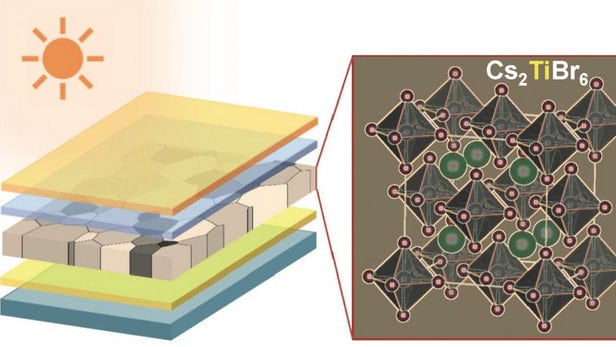by Michael Irving* Over the last few years, perovskite has proven itself to be a promising material for photovoltaic solar cells, but it's not without its problems
Over the last few years, perovskite has proven itself to be a promising material for photovoltaic solar cells, but it's not without its problems. Now, a team from Brown University and the University of Nebraska–Lincoln (UNL) has found a way to helps solve at least one of those issues, removing toxic lead from the device by substituting in titanium.
Perovskite earns its place in solar cells thanks to being cheaper to manufacture, more durable and more flexible than silicon, which is normally used. Originally, the material's major downside was its inefficiency in converting sunlight to electricity, but that has improved over the years, from less than four percent in 2009 to multi-layer designs boasting 26 percent efficiency by late 2016.
But efficiency isn't the only area with room for improvement. To be safe for commercial use, perovskite solar cells need to ditch the lead content that most of them contain.
"One of the big thrusts in perovskite research is to get away from lead-based materials and find new materials that are non-toxic and more stable," says Nitin Padture, senior author on the study. "Using computer simulations, our theoretician collaborators at UNL predicted that a class of perovskites with cesium, titanium and a halogen component (bromine or/and iodine) was a good candidate. The next step was to actually make a solar cell using that material and test its properties, and that's what we've done here."
Rather than replace silicon immediately, the transition is likely to be smoother if perovskite teams up with silicon in a tandem solar cell. In these designs, a layer of perovskite sits on top of a layer of silicon, and the two work together to convert more photons into electricity than either can alone. That's because perovskite is semi-transparent, allowing some photons to pass through to the silicon layer underneath.
"Tandem cells are the low-hanging fruit when it comes to perovskites," says Padture. "We're not looking to replace existing silicon technology just yet, but instead we're looking to boost it. So if you can make a lead-free tandem cell that's stable, then that's a winner. This new material looks like a good candidate."
In their new tandem design, the researchers made titanium-perovskite films with a relatively large bandgap of 1.8 electron volts. That means the material can absorb higher-energy photons from sunlight, letting the lower energy photons filter down to the silicon layer and be absorbed there.
This isn't the first time researchers have looked for a lead alternative, but in this case, the team says its design is more rust-resistant and can provide a higher total voltage than other materials being explored.
Currently, the titanium-perovskite cell only has an efficiency of 3.3 percent, which is far lower than silicon or even other perovskite designs. But the researchers say this isn't a bad figure for a first attempt with a new material, and there's plenty more that can be done to improve it.
The research was published in the journal Joule.
Source: Brown University
* A lifelong gamer and writer, Michael now writes about games after a freak accident left his two passions surgically inseparable. When he’s not lost in virtual or fictional worlds, he’s exploring the real one, reading up on local history or sampling fancy-pants beers. His native language is Simpsons quotes.
(https://newatlas.com)




